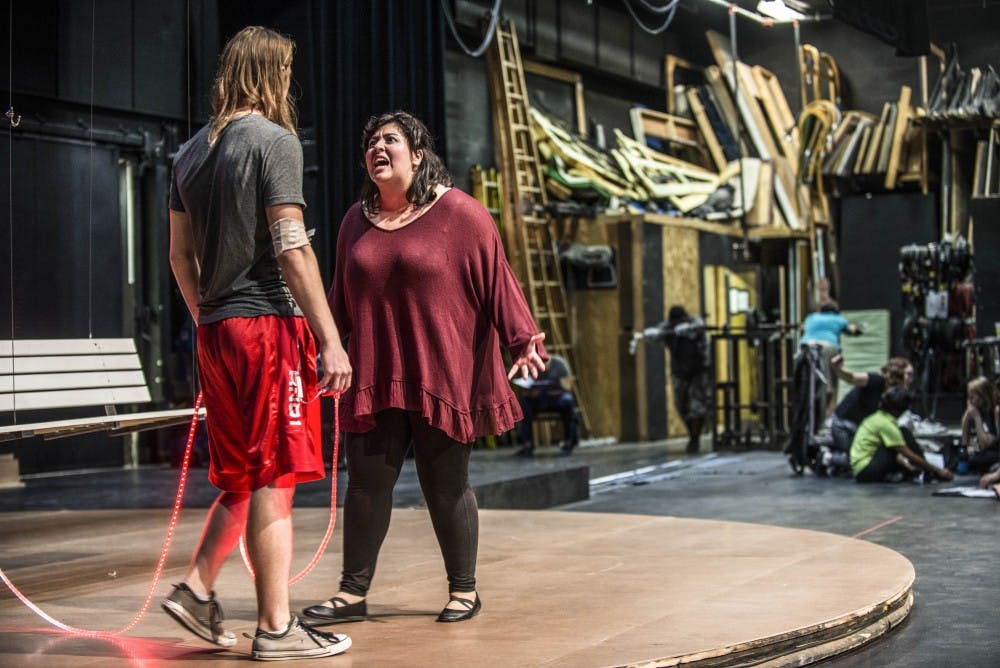Rodey Theatre’s doors will open Friday for Students Creating Really Awesome Productions with “A Bench at the Edge,” written by Luigi Jannuzzi. Play Director Samuel Shoemaker-Trejo said the show revolves around two main characters.
“‘A Bench at the Edge’ is about two individuals who meet at the literal representation of the metaphoric edge between life and death,” Shoemaker-Trejo said. “The physical space at the edge is actually an edge suspended over infinite abyss. In the back is life; in front is the abyss or death or eternity. It’s kind of up for interpretation what the other side is.”
Shoemaker-Trejo said that the first character, Man 1, is struggling between life and death, because he is strapped to a hospital bed and is unable to let himself die and yet, he cannot live. The second character, Man 2, who is a woman in this interpretation of the play, is struggling between life and death, as she is debating on ending her own life.
The theme of death and suicide is something Shoemaker-Trejo said is important to represent properly in media.
“For me, one of the other major, pillar reasons of why I decided to put on this production specifically is that I have had so many friends over the course of years who are touched by suicide specifically as an issue, death of family members, anxiety and many other issues that don’t necessarily see the public light of day and get talked about on the ordinary in an accurate sense,” Shoemaker-Trejo said.
He has been working with Agora Crisis Center to ensure that his production is respectful, he said.
“In the course of this play, I wanted to partner with Agora Crisis Center to do a talkback after the show and talk along the lines of informing the public and our University, especially since suicide is a prevalent issue for college students,” Shoemaker-Trejo said.
In the play, each character, right before their death, goes through a long thought process, which Shoemaker-Trejo said is extremely important to him.
“This isn’t a random occurrence,” Shoemaker said. “It’s a long, driven, directed process that somebody takes towards that path and while the actual act of attempting suicide, whether it’s successful or not, is by definition a choice in a moment and can be an impulsive choice, the lead up to it is very deliberate.”
Although there are two main characters, there are five additional supporting characters in the play, called bullets. Shoemaker-Trejo said these characters are either passing memories or passing people going onward into the abyss.
“I chose to represent the bullets in dance, in part, because I think they have significance beyond the momentary flickers that they could be represented as,” Shoemaker-Trejo said. “Also, actually showing their stories onstage is more impactful to an audience, I think, than hearing them.”
Having modern dance is something unique compared to other projects that SCRAP Productions has done before, according to Shoemaker-Trejo. In fact, he said this play in particular is a good teaching tool for a production completely made up of students, some of whom are not quite familiar with acting in college.
Get content from The Daily Lobo delivered to your inbox
“It’s one of the best (plays) to teach actors to act that’s out there, because it’s a two-man show that relies on subtext that’s entirely driven by that dynamic between two characters,” Shoemaker-Trejo said.
Teaching students is a major mission for SCRAP. Those interested in directing a show must apply the semester before the show would go on, he said. Decisions are made based on the merits of the proposed play and the opportunities it offers.
And being involved in a production like this is a lot of work. Shoemaker-Trejo said putting together a play is like trying to herd cats, but everyone is quite dedicated.
“We have people here pulling so many long hours, beyond what they really should be doing,” he said. “They volunteer that time for the show, and sometimes I’m like, ‘Please go sleep.’”
As for props, Shoemaker-Trejo claimed that there aren’t many. The main props are just two: a bench and an edge. However, there are still some challenging objects onstage that the crew must learn to work with, like a turntable.
“By the end of a production, as a director, once that show starts, it’s my job to step out of that picture,” Shoemaker-Trejo said. “The result of the work is the show. It’s what the audience sees, and it’s so odd, because what we produce is so dependent on the viewing public.”
The play will open Sept. 22 through 24 and continue Sept. 28 through Oct. 1. Sunday matinees are at 2 p.m., but all other shows will be at 7:30 p.m.
Tickets cost $12 for general admission, $10 for faculty and seniors and $8 for staff and students.
There will be a talkback with Agora Crisis Center following the show.
Ariel Lutnesky is a freelance culture reporter for the Daily Lobo. She can be contacted at culture@dailylobo.com or on Twitter @ArielLutnesky.






